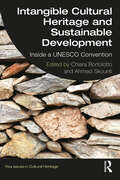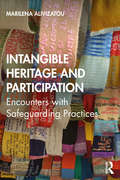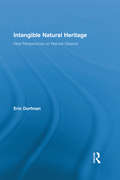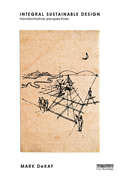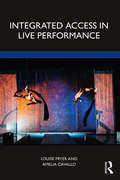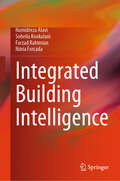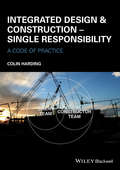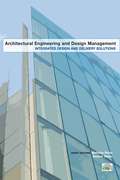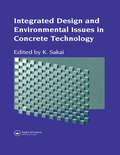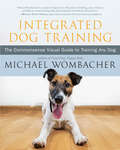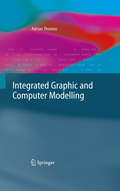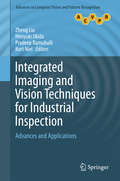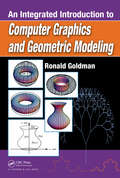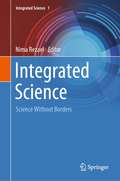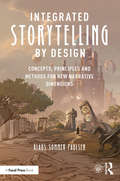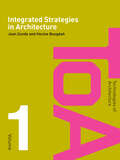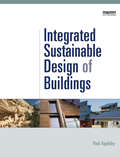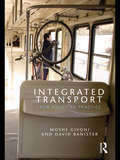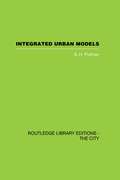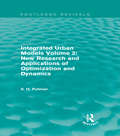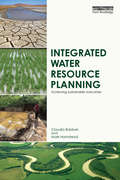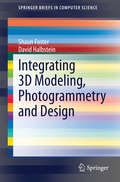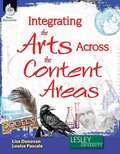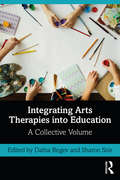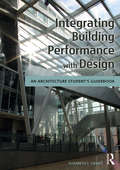- Table View
- List View
Intangible Cultural Heritage and Sustainable Development: Inside a UNESCO Convention (Key Issues in Cultural Heritage)
by Chiara Bortolotto Ahmed SkountiDrawing on debates about intangible cultural heritage (ICH) safeguarding at the local and international levels, Intangible Cultural Heritage and Sustainable Development: Inside a UNESCO Convention, explores the theoretical and practical implications of the intertwinement between these policy fields. Considering how sustainable development (SD) priorities are influencing representations of ICH, the volume questions how they are expanding the frontiers of the heritage realm and unsettling accepted understandings of the social uses of heritage. The contributing authors, who hail from a variety of different contexts and disciplinary backgrounds, explore these issues from a unique vantage point as both scholars and actors of the processes they analyze. Playing different roles in the implementation of the Convention, their positioning as insiders allows for a unique analytical perspective that is based on first-hand engagement with the practices of the Convention. Intangible Cultural Heritage and Sustainable Development: Inside a UNESCO Convention sheds light on the complexity, potential, and consequences of combining ICH and SD at the policy-making level and in heritage practices on the ground. It will be of interest to academics and students working in heritage studies, development studies, anthropology, archaeology, international law, political science, international relations, and sociology.
Intangible Heritage and Participation: Encounters with Safeguarding Practices
by Marilena AlivizatouIntangible Heritage and Participation examines participation as an intellectual and operational frame in safeguarding intangible heritage. Including case studies from the Netherlands, Belgium, Aotearoa New Zealand, Greece, Peru, Britain, Denmark, Sweden and Japan, the book provides an analysis of safeguarding as a museological framework and further investigates safeguarding practices in participatory research, memory-work and cultural transmission. Drawing on conversations about ‘the tyranny of participation’, the book looks into the complexities of participatory projects on the ground, from community research and collecting to the mapping of Indigenous values in environmental conservation and processes of active remembering of ‘difficult intangible heritage’ of forced migration, political violence and mental illness. Cautioning against the uncritical adoption of participation as a universal ethical discourse, Alivizatou argues that the ethics of cosmopolitanism should guide safeguarding practices at an international level. Intangible Heritage and Participation offers an original approach to thinking about and working with intangible heritage and, as such, should be essential reading for academics, researchers and students in, among others, the fields of cultural heritage studies, museology, anthropology and cultural development. It should also be of interest to heritage and museum professionals and anyone else interested in cultural heritage theory and practice.
Intangible Natural Heritage: New Perspectives on Natural Objects
by Eric DorfmanThe topic of intangible natural heritage is new, recently emerging as an important subject of inquiry. It describes the untouchable elements of the environment that combine to create natural objects, and help define our relationship to them. These elements can be sensory, like auditory landscapes, or processes like natural selection. As a concept, intangible natural heritage is growing in prominence, as museums are increasingly charged safeguarding and interpreting the milieux from which their objects originate. This book is a significant advance on the subject of intangible natural heritage; no book on the topic has yet been written and current scholarship is confined to a few isolated papers. As such, there exists a wide variety of perspectives on the topic. Intangible Natural Heritage presents a spectrum of opinion, making the first attempt at a unifying concept on which future work can be based. Authors from Europe, Asia, Australasia, Britain, and North America, address topics on scales from minute insects to sweeping landscapes. The common thread in these explorations is the importance of human relationships with nature that is passed down from generation to generation. In a world that is becoming increasingly fragile, recognizing and fostering these relationships has never been more vital.
Integral Sustainable Design: Transformative Perspectives
by Mark DeKayThis book offers practical and theoretical tools for more effective sustainable design solutions and for communicating sustainable design ideas to today's diverse stakeholders. It uses Integral Theory to make sense of the many competing ideas in this area and offers a powerful conceptual framework for sustainable designers through the four main perspectives of: Behaviours, Systems, Experiences and Cultures. It also uses human developmental theory to reframe sustainable design across four levels of complexity present in society: the Traditional, Modern, Postmodern, and Integral waves. Profuse with illustrations and examples, the book offers many conceptual tools including: - Twelve Principles of Integral Sustainable Design - Sixteen Prospects of Sustainable Design - Six Perceptual Shifts for Ecological Design Thinking - Five Levels of Sustainable Design Aesthetics - Ten Injunctions for Designing Connections to Nature
Integrated Access in Live Performance
by Louise Fryer Amelia CavalloTwelve per cent of UK theatregoers have a disability. This compares with 18% of the UK’s adult population. Directors can help build audiences as diverse as the population at large by making their art accessible to all. Live performances are increasingly being made accessible to people with sensory impairments not only to satisfy equality laws and the requirements of funding bodies, but also in the interest of diversity and as a catalyst for creativity. But how do you ensure you don’t throw out the access baby with the artistic bathwater? This book draws on the results of the Integrated Access Inquiry: Is It Working? A qualitative study with 20 theatremakers from around the UK, it was commissioned by Extant Theatre – the UK’s leading company of blind and visually impaired people, and combines feedback from disabled audiences with advice from the creative teams who have experimented with integrating access. It discusses the challenges and opportunities of working with disabled actors and building in audience access even before rehearsals begin. It offers strategies, case studies and a step-by-step guide to help creative people integrate access into their live performance for the benefit of all.
Integrated Building Intelligence
by Hamidreza Alavi Soheila Kookalani Farzad Rahimian Núria ForcadaThis book integrates of Building Information Modeling (BIM) and Decision Support Systems (DSS) in the field of building design, construction, and maintenance. The book explores how BIM and DSS technologies can be synergistically utilized to enhance performance, comfort, and maintenance efficiency in buildings. With an emphasis on practical applications, the book provides a comprehensive overview of the latest advancements in BIM and DSS, including real-world case studies and implementation guidelines. The book features illustrations, tables, and examples that aid in understanding complex concepts and demonstrate the practical application of BIM and DSS in building projects. Readers will gain a deep understanding of how BIM and DSS can be integrated to optimize building design, streamline construction processes, and improve facility management and maintenance. The main benefit of reading this book is that it provides a valuable resource for professionals in the architecture, engineering, and construction industries who want to leverage the power of BIM and DSS to enhance their building projects. Additionally, the book explores how BIM and DSS can contribute to energy efficiency.
Integrated Design and Construction - Single Responsibility
by Chartered Institute of Building Colin HardingManufacturing and service industries have significantly improved their levels of productivity, quality, and profitability over the past 30 years, whereas in the construction industry similar levels of improvement have been impossible to achieve. Numerous reports have identified fragmentation of the industry's management structures and processes as the underlying cause of the waste and inefficiencies that keep costs high and margins low. Integrated Design and Construction is an integrated yet competitive form of procurement, design and project delivery based on the principle of purchasing any other high value warranted manufactured product. Such an approach would make the construction process more like other manufacturing industries, allowing contractors to make similar improvements to those already seen in other manufacturing industries. Designed for use by experienced construction professionals, familiar and proficient with traditional design and construction system best practice, this Code of Practice provides both client and constructor with the necessary information to adopt this approach to create well-designed and well-constructed products, fully meeting client needs.
Integrated Design and Delivery Solutions (Architectural Engineering and Design Management)
by Matthijs Prins Robert OwenIntegrated Design and Delivery Solutions (IDDS) represent a significant new research trajectory in the integration of architecture and construction through the rapid adoption of new processes. This book examines the ways in which collaboration and new methods of contracting and procurement enhance skills and improve processes in terms of lean and sustainable construction. Based on high quality research and practice-based examples that provide key insights into IDDS and its future potential, this book surveys the technologies that are being employed to create more sustainable buildings with added value for clients, stakeholders and society as whole.
Integrated Design and Environmental Issues in Concrete Technology
by K. SakaiThe two themes of integration of structural and durability design, and integration of concrete technologies in relation to global environmental issues are drawn together in this book. It presents the views of distinguished international researchers and engineers on these key topics as the 21st century approaches.
Integrated Dog Training: The Commonsense Visual Guide to Training Any Dog
by Michael WombacherA Comprehensive Dog Training Course in a Book, with Step-by-Step Photos and Guidance Designed for quick reference while working with your dog, this large-format guidebook features the full gamut of training exercises — each illustrated with photos and clear instructions. It offers a wealth of ways to approach various dogs and scenarios, whether you&’re training a puppy to sit or correcting training issues in a mature dog. Michael Wombacher, a trainer with decades of experience, knows all the competing dog training theories but also knows that in reality, it is a range of methods that gets dogs and their humans where they need to be. His Integrated Dog Training is a much-needed commonsense approach that avoids cookie-cutter dictates and recognizes the individuality of each dog. He includes straightforward discussions of situation-specific equipment, treats, and commands, as well as a variety of age- and environment-variable approaches. Easy-to-use, image-driven, and immediately applicable, this is a truly unique, invaluable resource that gets people and dogs in sync and happy lifelong.
Integrated Graphic and Computer Modelling
by Adrian ThomasComputer languages and computer graphics have become the primary modes of human-computer interaction. This book provides a basic introduction to "Real and Virtual Environment" computer modelling. Graphics models are used to illustrate both the way computer languages are processed and also used to create computer models of graphic displays. Computer languages have been bootstrapped from machine code, to high-level languages such as Java, to animation scripting languages. Integrating graphic and computer models takes this support for programming, design and simulation work, one step further, allowing interactive computer graphic displays to be used to construct computer models of both real and virtual environment systems. The Java language is used to implement basic algorithms for language translation, and to generate graphic displays. It is also used to simulate the behaviour of a computer system, to explore the way programming and design-simulation environments can be put together.
Integrated Imaging and Vision Techniques for Industrial Inspection: Advances and Applications (Advances in Computer Vision and Pattern Recognition)
by Zheng Liu Hiroyuki Ukida Pradeep Ramuhalli Kurt NielThis pioneering text/reference presents a detailed focus on the use of machine vision techniques in industrial inspection applications. An internationally renowned selection of experts provide insights on a range of inspection tasks, drawn from their cutting-edge work in academia and industry, covering practical issues of vision system integration for real-world applications. Topics and features: presents a comprehensive review of state-of-the-art hardware and software tools for machine vision, and the evolution of algorithms for industrial inspection; includes in-depth descriptions of advanced inspection methodologies and machine vision technologies for specific needs; discusses the latest developments and future trends in imaging and vision techniques for industrial inspection tasks; provides a focus on imaging and vision system integration, implementation, and optimization; describes the pitfalls and barriers to developing successful inspection systems for smooth and efficient manufacturing process.
An Integrated Introduction to Computer Graphics and Geometric Modeling (Chapman & Hall/CRC Computer Graphics, Geometric Modeling, and Animation Series)
by Ronald GoldmanTaking a novel, more appealing approach than current texts, An Integrated Introduction to Computer Graphics and Geometric Modeling focuses on graphics, modeling, and mathematical methods, including ray tracing, polygon shading, radiosity, fractals, freeform curves and surfaces, vector methods, and transformation techniques. The author begins with f
Integrated Science: Science Without Borders (Integrated Science #1)
by Nima RezaeiThe “INTEGRATED SCIENCE: Science without Borders” is the first volume of INTEGRATED SCIENCE Book series, aims to publish the results of the most update ideas and reviews in transdisciplinarity fields, to highlight integration of different disciplines, including formal sciences, physical-chemical sciences and engineering, biological sciences, medical sciences, and social sciences. This is especially focused on the research involving the integration of two of more academic fields offering an innovative view, which is one of the main focuses of Universal Scientific Education and Research Network (USERN); science without borders. The whole world is suffering from complex problems; these are actually borderless problems; so, borderless solution could be the solution for such complex problems. Transdisciplinarity, as a domain that researchers work jointly, using shared conceptual framework drawing together disciplinary-specific theories, concepts and approaches to address common problem. Lack of confidence, lack of expertise, complexities of healthcare, the confusing nature of healthcare environments and lack of organization and standardization became obstacles to successful communication. Consequently, the book is to provide an overview of the basic elements of transdisciplinary studies and integrated science. The unique aspect of this book, privileging it from other books, is covering all aspects of science as a true one nature.
Integrated Storytelling by Design: Concepts, Principles and Methods for New Narrative Dimensions
by Klaus Sommer PaulsenThis pioneering work equips you with the skills needed to create and design powerful stories and concepts for interactive, digital, multi-platform storytelling and experience design that will take audience engagement to the next level. Klaus Sommer Paulsen presents a bold new vision of what storytelling can become if it is reinvented as an audience-centric design method. His practices unlock new ways of combining story with experience for a variety of existing, new and upcoming platforms. Merging theory and practice, storytelling and design principles, this innovative toolkit instructs the next generation of creators on how to successfully balance narratives, design and digital innovation to develop strategies and concepts that both apply and transcend current technology. Packed with theory and exercises intended to unlock new narrative dimensions, Integrated Storytelling by Design is a must-read for creative professionals looking to shape the future of themed, branded and immersive experiences.
Integrated Strategies in Architecture (Technologies of Architecture)
by Joan Zunde Hocine BougdahThis key text presents students with a holistic view of the building design process, bridging the gap between the theory and practice of constructing and assembling buildings. Integrated Strategies in Architecture encourages and enables students to gain a sound understanding of the purpose of buildings, the specialisms that contribute and the available technology. Zunde and Bougdah thoroughly introduce and expose the concepts and technologies that underlie the design process, setting current design in context as part of an evolutionary process, exemplified through historic and contemporary models, and emphasizing the importance of applying a broad variety of technologies in the creation of successful buildings. Topics covered include: space planning, colour theory, communication, management, aesthetics, structures and environmental control. This essential text will greatly assist students of architecture and its technology, construction management and building surveying as well as practitioners as they strive to build better buildings.
Integrated Sustainable Design of Buildings
by Paul ApplebyIntegrated Sustainable Design of Buildings aims to provide a guide to members of design and masterplanning teams on how to deliver sustainable development and buildings cost effectively, meeting current and emerging UK and international statutory and planning requirements. Using a series of case histories and examples from the author's ten years of providing sustainability advisory services the book sets out a clear and understandable strategy that deals with all aspects of sustainable design and construction and the implications for delivery, costs, saleability and long term operation. The extensive scope includes all aspects of environmental, social and economic sustainability, including strategies to reduce carbon emissions and the impact of climate change. Integrated Sustainable Design of Buildings appeared in the Cambridge Top 40 Sustainability Books of 2010.
Integrated Transport: From Policy to Practice
by Moshe Givoni David BanisterTravel is an essential part of everyday life and today most journeys are multimodal. It is the total travel experience that counts and integrated transport must reduce the inconvenience of transfers between modes. Most research and many publications on transport policy advocate sustainable transport, but the priority given to integration has been negligible. Yet integration is one of the most important means to advance sustainable transport and sustainability more generally. While integrated transport systems are seen to be an ideal, there is a failure to make the transition from policy to practice. The authors argue that the achievement of sustainable transport is still a dream, as an integrated transport policy is a prerequisite for a sustainable transport system. It is only when the two concepts of sustainability and integration operate in the same direction and in a positive way that real progress can be made. In this book, transportation experts from across the world have addressed the questions about what is integration, why is it so important and why is it so hard to achieve? The book provides an in-depth analysis of these issues and it aims to provide a better understanding of the subject, about what should be strived for, about what is realistic to expect, and about how to move forward towards a more integrated provision of transport infrastructure, services and management.
Integrated Urban Models Volume 1 (RLE: The City): New Research And Applications Of Optimization And Dynamics
by S. H. PutmanThis book was first published in 1983.
Integrated Urban Models Volume 2: New Research and Applications of Optimization and Dynamics (Routledge Revivals)
by Stephen H. PutmanFollowing on from Integrated Models Volume 1: Policy Analysis of Transportation and Lane Use (Routledge Library Editions, 2006), this book bridges the gap between the scholars and the practitioners of transportation and land-use modelling. First published in 1991, chapters discuss model-calibration and model-solution problems, describe a series of numerical and policy analyses, and propose potential directions for location and land-use research. This reissue will be of particular value to undergraduate and postgraduate geography students with an interest in integrated urban modelling; in particular, the research conducted in the field over the past two decades.
Integrated Water Resource Planning: Achieving Sustainable Outcomes
by Claudia Baldwin Mark HamsteadIntegrated Water Resource Planning provides practical, evidence-based guidance on water resource planning. In a time of heightened awareness of ecosystem needs, climate change, and increasing and conflicting demands on resources, water professionals and decision-makers around the world are on a steep learning curve. This book presents an international examination of water reform experiences, and provides lessons in how to manage environmental uncertainties, long term management, and increase in demand. It breaks the process down into a series of common steps, applies program logic and evaluation theory, and discusses best practices in assessment, decision making and community engagement. Importantly it recognises the large variation in available knowledge and capacity, risk and scale, and discusses a range of approaches that can be used for different circumstances. The book will fill in the gaps for professionals in interdisciplinary teams including sociologists, hydrologists, engineers, ecologists, and community consultation specialists, by providing a basic grounding in areas outside their usual expertise, and will provide ammunition to community stakeholders in their quest to ensure that water planning outcomes are justified and justifiable. Case studies provide an understanding of the context, practical tools and implementation techniques for achieving sustainable outcomes, and the multi-disciplinary approach and insights offered in this book will be transposable and instructive for water professionals worldwide.
Integrating 3D Modeling, Photogrammetry and Design
by Shaun Foster David HalbsteinThis book looks at the convergent nature of technology and its relationship to the field of photogrammetry and 3D design. This is a facet of a broader discussion of the nature of technology itself and the relationship of technology to art, as well as an examination of the educational process. In the field of technology-influenced design-based education it is natural to push for advanced technology, yet within a larger institution the constraints of budget and adherence to tradition must be accepted. These opposing forces create a natural balance; in some cases constraints lead to greater creativity than freedom ever can - but in other cases the opposite is true. This work offers insights into ways to integrate new technologies into the field of design, and from a broader standpoint it also looks ahead, raising further questions and looking to the near future as to what additional technologies might cause further disruptions to 3D design as well as wonderful creative opportunities.
Integrating The Arts Across The Content Areas
by Lisa Donovan Louise PascaleBring the arts back into the classroom with arts-based activities and strategies to use in language arts, mathematics, science, and social studies instruction. Developed in conjunction with Lesley University, this resource helps teachers to gain a better understanding of why and how to use the arts to reach and engage students. Developed to help motivate disengaged students, this professional resource provides activities, concrete examples, and stories from teachers already implementing art-based curriculum. The strategies are presented in categories that include: dramatic movement, storytelling, poetry, music/rhythm, and visual arts. This resource supports College and Career Readiness Standards.
Integrating Arts Therapies into Education: A Collective Volume
by Dafna Regev and Sharon SnirThis book offers a variety of effective, concrete ways to better assimilate arts therapies in the educational system. Featuring leading art therapists and the models they have honed as a result of their arts experience in education, Integrating Arts Therapies into Education discusses systemic issues and challenges related to work in the education system such as confidentiality, multidisciplinary teamwork with educators and contact with parents. Divided into two parts, the first discusses systemic issues related to work in the education system, and the second presents a series of dedicated models that can be implemented in the education system. Each chapter consists of a theoretical background, a description of the working model, a clinical example or case study and a summary. Creative arts and expressive therapy practitioners will find this guide filled with the most effective ways to approach and deliver arts therapies in a school setting.
Integrating Building Performance with Design: An Architecture Student’s Guidebook
by Elizabeth J. GrantIntegrating Building Performance with Design shows you the importance of designing for building performance early in your architectural design process. The book offers you simple tools and exercises, along with examples of built professional work and successful student projects illustrated by more than 100 full color images to help you with your work. Topics include site, solar orientation, thermal comfort, building enclosure, daylighting, passive heating and cooling, active heating and cooling, indoor air quality, stormwater, and rainwater harvesting.?
